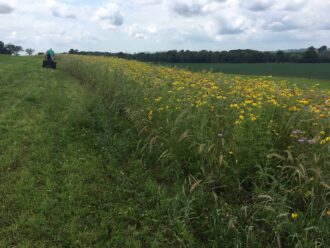For almost 20 years, farmers and researchers in Iowa have been experimenting with prairie strip plantings to help reduce surface runoff from agricultural fields. The STRIPS project, which stands for "Science-based Trials of Rowcrops Integrated with Prairie Strips," is based at Iowa State University (ISU). Since 2003, the team of farmers, researchers, and educators has been strategically placing native prairie plantings in crop fields to retain soil and prevent runoff.
In 2007, Seth Watkins, a farmer near Clarinda, Iowa, became the first farmer to adopt STRIPS on his farm. The Iowa STRIPS project applied for a SARE grant in 2009 to scale-up their research. With the grant, they looked at the effects of planting prairie strips in row-crop fields at 12 watersheds at the Neal Smith Wildlife Refuge near Prairie City, Iowa.
"We found that strategically converting a relatively small amount (10-20%) of an agricultural drainage area into native perennial vegetation can significantly reduce surface water runoff," said Matthew Helmers, SARE grantee, and Professor and Extension Agricultural Engineer at ISU. "This can lead to reduced sediment and nutrient export from the field."
The prairie plants' resilient nature, with their complex root systems and perennial growth, was ideal for water absorption and soil retention, and they provided continuous living cover. The prairie strips contributed to improved water quality and phosphorus and sediment loss reduction with minimal impact on crop production. The planted areas also created habitats for pollinators, beneficial insects, and other wildlife.
Dozens of Iowa farmers adopted STRIPS in the five years following the findings from the Neal Smith Wildlife Refuge demonstrations. And today, prairie strips are part of the continuous Conservation Reserve Program under CP43. More than 14,000 acres of prairie strips have been planted in more than 14 states (STRIPS, 2022).
prairie strip Vegetation
ISU graduate student Lydia English received a 2018 SARE grant to conduct vegetation surveys on 21 farms that adopted STRIPS in Iowa between 2012-2016. English learned that grey-headed coneflower and Indian grass were the most common prairie species found in those prairie strips, while dandelion and Canada thistle were the most common weedy species. Results showed that a more diverse seed mix resulted in a more diverse stand of vegetation. However, including more species in the seed mix alone did not result in a lower abundance of weedy species.
"Over 80% of the farmer cooperators surveyed stated that their plant identification skills increased," said English. "And 75% indicated they were further interested in learning more about plant dynamics in their prairie strips."
expanding The Prairie Strip network
In 2021, researchers at Michigan State University's W.K. Kellogg Biological Station began collaborating with the STRIPS project to increase the adoption of prairie strips across the Eastern Corn Belt. A 2021 SARE grant provided support for graduate student Corinn Rutkoski to share information about prairie strip implementation and their associated pollinator conservation benefits with farmers in southern Michigan. MiSTRIPS is expanding STRIPS’ reach by connecting agencies, stakeholders, farmers, and farm landowners in Michigan with technical support, resources, and networking opportunities.
"I like how the practice strives to be compatible with existing systems, fitting with current crops and farming equipment," said Craig Ficenec with Sand County Foundation. This nonprofit organization received SARE support in 2016 to extend and adapt the experience of the Iowa State University prairie strips project into Wisconsin. "And yet it's a little bit radical, converting just a fraction of cropland back to prairie. And most of all, done right, it's effective and potentially a less costly way to protect water quality than traditional structural practices. And it provides wildlife habitat at the same time. Farmers who convert strategically selected areas of annually cropped ground to permanent and diverse vegetative cover can potentially meet rising expectations for water quality protection with minimal impacts on farm profitability."
Wisconsin farmer Dan Stoffel worked with the Sand County Foundation on the 2016 SARE project. Stoffel grows soybeans, alfalfa, and oats on 800 acres of rolling terrain that has been in his family since the late 1870s. On Stoffel's farm, two fields, in particular, had some problematic water flow areas.
"Initially, I wanted just to get a sense of how they look and work," said Stoffel in a 2018 interview. "Two years into this, I've found their root structures and plant residue makes a big difference. They hold their own against the water."
Watch a video of Dan Stoffel talking about his experiences with planting prairie strips on his Wisconsin farm.
View Related SARE Grants:
- Mixing Reconstructed Prairie with Cropland to Balance Food and Biofuel Production with Environmental Quality (LNC09-314)
- Advancing cost effective water quality improvement in the North Central Region through farmer-led engagement for prairie filter strips (LNC16-378)
- Linking Agricultural Production and Conservation Through In-field Prairie Plantings (GNC18-257)
- Conserving pollinators on farms with prairie strips (GNC21-336)
